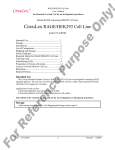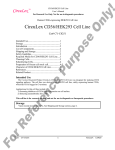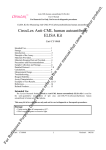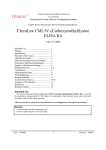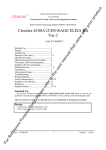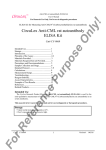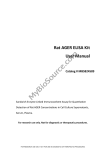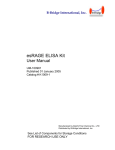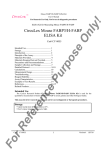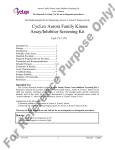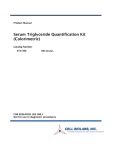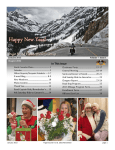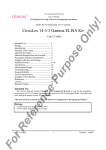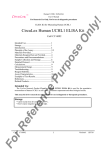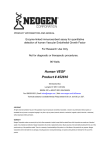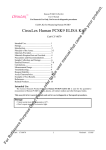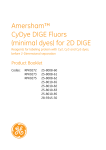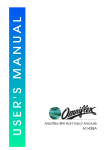Download CircuLex AGE-RAGE in vitro Binding Assay Kit
Transcript
t. uc od ith Non-Radioisotopic Kit for Measuring AGE-RAGE Interaction in vitro ur pr AGE-RAGE in vitro Binding Assay Kit User’s Manual For Research Use Only, Not for use in diagnostic procedures yo CircuLex TM m ew CircuLex AGE-RAGE in vitro Binding Assay Kit at th al an u rm se fe rt o th eu Intended Use................................................ 1 Storage......................................................... 1 Introduction ................................................. 2 Principle of the Assay.................................. 2-3 Summary of Procedure..................................4 Materials Provided ...................................... 5 Materials Required but not Provided .......... 6 Precautions and Recommendations............. 7 Detailed Protocol......................................... 8-10 Evaluation of Results ................................. 11 Troubleshooting .......................................... 12 Reagent Stability ........................................ 12 Assay Characteristics ..................................13-16 References....................................................17 Related Product............................................18 ca Cat# CY-8151 re Intended Use nl y! Pl ea se The CycLex Research Product CircuLex AGE-RAGE in vitro Binding Assay Kit is primarily designed to screening inhibitors of AGE2 (glyceraldehyde-modified AGE)-sRAGE interaction (soluble RAGE) in vitro. In addition, this kit can be used for the rapid and sensitive evaluation of inhibitor candidates as well as characterization of AGE2-sRAGE interaction in vitro. The recombinant sRAGE used in this assay kit was specially designed by CycLex for keeping the correct conformation to bind efficiently to AGE2-BSA but not to BSA, which are immobilized on the microplate surface. This technique allows us measuring the interaction of recombinant sRAGE to AGE2-BSA in a solid-phase assay system such as a conventional ELISA system. Pu rp os eO Applications for this kit include: 1) Screening inhibitors of AGE-sRAGE interaction in vitro. 2) Characterization of inhibitor candidates of AGE2-sRAGE interaction in vitro. 3) Screening monoclonal antibodies that inhibit AGE2-sRAGE interaction in vitro. 4) Characterization of AGE2-sRAGE interaction in vitro. Storage er en ce • Upon receipt, store all other components at 4°C. • Don’t expose reagents to excessive light. Fo rR ef Cat#: CY-8151 1 Version#: 150817 t. uc od pr AGE-RAGE in vitro Binding Assay Kit User’s Manual For Research Use Only, Not for use in diagnostic procedures yo ur CircuLex TM ith Introduction rt o th eu se rm an u al th at ca m ew Advanced glycation end products (AGEs) are important biochemical compounds found in diabetes and may be associated with inflammatory processes. In the vessel wall, AGEs are bound to specific receptors to modulate many cellular properties by activating several signaling pathways. One of these receptors is called “Receptor for Advanced Glycation End product” (RAGE). RAGE is a multi-ligand member of the immunoglobulin superfamily of cell surface molecules that is expressed in a variety of cell lines, including endothelial cells, smooth muscle cells, mononuclear phagocytes, pericytes, neurons, cardiac myocytes, mesangial cells and hepatocytes (1, 2). RAGE interacts with different structures to transmit a signal into the cell and recognizes three-dimensional structures rather than specific amino acid sequences. Therefore, RAGE seems to fulfill the requirements of a pattern-recognition receptor. As a member of the immunoglobulin superfamily, it interacts with a diverse class of ligands, including AGEs (1, 3), HMGB1 (also known as Amphoterin) (4), amyloid β-peptide (5), amyloid A (6), leukocyte adhesion receptors (7), prions (8), Escherichia coli curli operons (9), β-sheet fibrils (10) and several members of the S100 protein superfamily including S100/calgranulins (11). Thus RAGE may have potential involvement in several pathological processes including inflammation, diabetes, Alzheimer’s disease (AD), systemic amyloidosis and tumor growth (12). AGE-RAGE interaction enhances the expression of genes encoding cytokines, growth factors and adhesion molecules, and increases the classical acute phase proteins. Potential approaches to prevention and treatment of diabetes and its complications include inhibition of AGE formation, breakage of preformed AGE-proteins crosslink, blockade of AGE-RAGE interactions with RAGE competitors, antibody antagonists and RAGE specific metabolic inhibition. Inhibition of AGE-RAGE complex formation is able to suppress the levels of pro-inflammatory cytokines and growth factors and may be considered as a target for overcoming diabetic complications. fe Principle of the Assay er en ce Pu rp os eO nl y! Pl ea se re The CycLex Research Products CircuLex AGE-RAGE in vitro Binding Assay Kit is a semi-quantitative solid phase binding assay between recombinant His-tagged soluble RAGE (sRAGE) and glyceraldehyde-modified BSA (AGE2-BSA). Plates are pre-coated with AGE2-BSA, which is able to bind to recombinant His-tagged sRAGE. Horse radish peroxidase (HRP)-conjugated anti-His-tag monoclonal antibody specifically reacts with recombinant His-tagged sRAGE that is trapped with AGE2-BSA immobilized on the microplate well surface. The CircuLex AGE-RAGE in vitro Binding Assay Kit may be used to characterize AGE-RAGE interaction as well as to screen inhibitors of AGE-RAGE interaction in vitro. To perform the test, the recombinant His-tagged sRAGE is diluted in Reaction Buffer, pipetted into the wells and allowed to bind to AGE2-BSA immobilized on the wells. After wash the wells, the amount of bound recombinant His-tagged sRAGE is measured by binding it with HRP-conjugated anti-His-tag monoclonal antibody, which then catalyzes the conversion of the chromogenic substrate tetra methylbenzidine (TMB) from a colorless solution to a blue solution (or yellow after the addition of stopping reagent). The color is quantitated by spectrophotometry and reflects the relative amount of recombinant His-tagged sRAGE that binds to AGE2-BSA on the wells. Fo rR ef Cat#: CY-8151 2 Version#: 150817 t. uc od pr yo ur CircuLex AGE-RAGE in vitro Binding Assay Kit User’s Manual For Research Use Only, Not for use in diagnostic procedures TM ca m ew ith For screening inhibitors of AGE-RAGE interaction in vitro, test compounds or the inhibitor candidates including a monoclonal antibody are added to appropriate amount of His-tagged sRAGE in the wells pre-coated with AGE2-BSA in a similar fashion as described above, followed by evaluation of inhibitory effect on AGE-RAGE interaction by measuring the amount of His-tagged sRAGE2 on the wells. al th at Schematic Representation of the CircuLex AGE-RAGE in vitro Binding Assay Kit Principle fe rt o th eu se rm an u Schematic Representation of AGE-RAGE in vitro Binding Assay Kit Principle re wash nl y! Pl : AGE2-BSA ea se wash : HRP-conjugated anti-His-tag mAb : TMB er en ce Pu rp os eO : His-tagged sRAGE Fo rR ef Cat#: CY-8151 3 Version#: 150817 t. uc od pr AGE-RAGE in vitro Binding Assay Kit User’s Manual For Research Use Only, Not for use in diagnostic procedures yo ur CircuLex TM ith Summary of Assay Procedure Incubate for 1 hour at room temp. ca m Wash the wells ew Add 100 µL of recombinant His-tagged sRAGE to the wells Add 100 µL of HRP-conjugated Anti-His-tag monoclonal Antibody. at Incubate for 1 hour at room temp. al th Wash the wells er en ce rm Pu rp os eO nl y! Pl ea se re fe rt o th eu se Add 100 µL of Stop Solution Measure absorbance at 450 nm an u Add 100 µL of Substrate Reagent Fo rR ef Cat#: CY-8151 4 Version#: 150817 t. uc od pr AGE-RAGE in vitro Binding Assay Kit User’s Manual For Research Use Only, Not for use in diagnostic procedures yo ur CircuLex TM ith Materials Provided ew All samples should be assayed in duplicate. The following components are supplied and are sufficient for the one 96-well microtiter plate kit. ca m AGE2-BSA coated Microplate: One microplate supplied ready to use, with 96 wells (12 strips of 8-well) in a foil, zip-lock bag with a desiccant pack. Wells are coated with AGE2-BSA (glyceraldehyde-modified BSA). th at BSA coated Microplate: One microplate supplied ready to use, with 96 wells (12 strips of 8-well) in a foil, zip-lock bag with a desiccant pack for non-specific binding control. Wells are coated with BSA. an u al Recombinant His-tagged sRAGE: One vial containing 1.6 µg of lyophilized recombinant His-tagged human sRAGE. rm Reaction Buffer: One bottle containing 50 mL of 1X buffer; used for reconstitution and dilution of Recombinant His-tagged sRAGE, and binding reaction. Ready to use. th eu se 20X Inhibitor Control Compound: 250 µM compound DP, which was discovered in commercial chemical library by CycLex using this CircuLex AGE-RAGE in vitro Binding Assay Kit. This compound DP may be irritating to the skin, eyes and upper respiratory tract and hazardous in case of ingestion. This is also suspected to be carcinogenic. Please handle carefully according to “Guidelines on Handling Chemical Carcinogens and Mutagens” rt o HRP conjugated anti-His-tag monoclonal antibody: One bottle containing 30 mL of HRP (horseradish peroxidase) conjugated anti-His-tag monoclonal antibody. Ready to use. re fe 10X Wash Buffer: One bottle containing 100 mL of 10X buffer containing Tween®-20 se Substrate Reagent: One bottle containing 20 mL of the chromogenic substrate, tetra methylbenzidine (TMB). Ready to use. er en ce Pu rp os eO nl y! Pl ea Stop Solution: One bottle containing 20 mL of 1 N H2SO4. Ready to use. Fo rR ef Cat#: CY-8151 5 Version#: 150817 t. uc od pr AGE-RAGE in vitro Binding Assay Kit User’s Manual For Research Use Only, Not for use in diagnostic procedures yo ur CircuLex TM ew • Pipettors: 2-20 µL, 20-200 µL and 200-1000 µL precision pipettors with disposable tips. ith Materials Required but not Provided • Precision repeating pipettor ca m • Orbital microplate shaker at • Wash bottle or multichannel dispenser for plate washing th • Microcentrifuge and tubes for sample preparation. al • Vortex mixer an u • Microplate washer: optional (Manual washing is possible but not preferable) se rm • Plate reader capable of measuring absorbance in 96-well plates at dual wavelengths of 450 nm/540 nm. Dual wavelengths of 450/550 or 450/595 nm can also be used. The plate can also be read at a single wavelength of 450 nm, which will give a somewhat higher reading. eu • (Optional) Software package facilitating data generation and analysis th • 500 or 1000 mL graduated cylinder rt fe • Deionized water of the highest quality o • Reagent reservoirs er en ce Pu rp os eO nl y! Pl ea se re • Disposable paper towels Fo rR ef Cat#: CY-8151 6 Version#: 150817 t. uc od pr AGE-RAGE in vitro Binding Assay Kit User’s Manual For Research Use Only, Not for use in diagnostic procedures yo ur CircuLex TM ith Precautions and Recommendations ew • Allow all the components to come to room temperature before use. m • All microplate strips that are not immediately required should be returned to the zip-lock pouch, which must be carefully resealed to avoid moisture absorption. ca • Do not use kit components beyond the indicated kit expiration date. at • Use only the microtiter wells provided with the kit. al th • Rinse all detergent residue from glassware. an u • Use deionized water of the highest quality. rm • Do not mix reagents from different kits. se • The buffers and reagents in this kit may contain preservatives or other chemicals. Care should be taken to avoid direct contact with these reagents. eu • Do not mouth pipette or ingest any of the reagents. th • Do not smoke, eat, or drink when performing the assay or in areas where samples or reagents are handled. rt o • Dispose of tetra-methylbenzidine (TMB) containing solutions in compliance with local regulations. er en ce Pu rp os eO nl y! Pl ea se re fe • CAUTION: Sulfuric Acid is a strong acid. Wear disposable gloves and eye protection when handling Stop Solution. Fo rR ef Cat#: CY-8151 7 Version#: 150817 t. uc od pr AGE-RAGE in vitro Binding Assay Kit User’s Manual For Research Use Only, Not for use in diagnostic procedures yo ur CircuLex TM ith Detailed Protocol ca m ew The CycLex Research Product CircuLex AGE-RAGE in vitro Binding Assay Kit is provided with removable strips of wells so the assay can be carried out on separate occasions using only the number of strips required for the particular determination. Since conditions may vary, individual user should optimize the amount of Recombinant His-tagged sRAGE for inhibitor screening from dose-response curve. Disposable pipette tips and reagent troughs should be used for all transfers to avoid cross-contamination of reagents or samples. th at I. Preparation of Working Solutions an u al 1. Prepare a working solution of Wash Buffer by adding 100 mL of the 10X Wash Buffer (provided) to 900 mL of deionized water. Mix well. Store at 4°C for two weeks or -20°C for long-term storage. se rm 2. Reconstitute the Recombinant His-tagged sRAGE with 0.8 mL of Reaction Buffer. After dissolved by gently mixing, immediately dispense in small aliquots (e.g. 200 µL) to micro-centrifuge tubes and store at below -70°C to avoid repeated freezing and thawing. Final concentration of the reconstituted recombinant His-tagged sRAGE should be 2 µg/mL, which is referred as a Master solution of Recombinant His-tagged sRAGE. o th eu 3. Prepare His-tagged sRAGE Solutions by 2-fold serially diluting the Master solution (2 µg/mL) to an appropriate concentration (usually 100-1.56 ng/mL only for drawing dose-response curve) with Reaction Buffer at the time of assay (See “II. Standard Assay for Drawing Dose-Response Curve” below.). re fe rt Note-1: For an inhibitor screening assay, the Master solution (2 µg/mL) should be diluted with Reaction Buffer to appropriate concentration, which shows OD value does not exceed plateau range in dose-response curve. se Note-2: Prepare appropriate volume for your assay. Discard any unused His-tagged sRAGE Solutions after diluted. Pl ea II. Standard Assay for Drawing Dose-Response Curve nl y! 1. Remove the appropriate number of microtiter wells of AGE2-BSA coated Microplate from the foil pouch and place them into the well holder. Return any unused wells to the foil pouch, refold, seal with tape and store at 4°C. os eO 2. Prepare 2-fold serially diluted His-tagged sRAGE Solutions (100-1.56 ng/mL and Reaction Buffer only). Pu rp 3. Pipette 100 µL of the His-tagged sRAGE Solutions (100-1.56 ng/mL and Reaction Buffer only) in duplicates, into the wells. Cover with plate sealer or lid, and incubate at room temperature (ca.25°C) for 1 hour, shaking at ca. 300 rpm on an orbital microplate shaker. er en ce 4. Wash 4-times by filling each well with Wash Buffer (350 µL) using a squirt bottle, multi-channel pipette, manifold dispenser or microplate washer. Remove residual Wash Buffer by gentle tapping or aspiration. 5. Add 100 µL of HRP conjugated anti-His-tag monoclonal antibody into each well, cover with Fo rR ef Cat#: CY-8151 8 Version#: 150817 t. uc od pr AGE-RAGE in vitro Binding Assay Kit User’s Manual For Research Use Only, Not for use in diagnostic procedures ur CircuLex TM ith yo plate sealer or lid, and incubate at room temperature (ca.25°C) for 1 hour, shaking at ca. 300 rpm on an orbital microplate shaker. ew 6. Wash 4-times as same as in step 4. ca m 7. Add 100 µL of Substrate Reagent into each well. Avoid exposing the microtiter plate to direct sunlight. Covering the wells with e.g. aluminum foil is recommended. Return Substrate Reagent to 4°C immediately after the necessary volume is removed. th at 8. Incubate the wells at room temperature (ca.25°C) for 5-15 minutes, shaking at ca. 300 rpm on an orbital microplate shaker. (Appropriate incubation time may vary, and incubation time can be extended up to 30 minutes if the reaction temperature is below than 20°C). an u al 9. Add 100 µL of Stop Solution to each well in the same order as the previously added Substrate Reagent. se rm 10. Measure absorbance in each well using a spectrophotometric plate reader at dual wavelengths of 450/540 nm. Dual wavelengths of 450/550 or 450/595 nm can also be used. Read the plate at 450 nm if only a single wavelength can be used. Wells must be read within 30 minutes of adding the Stop Solution. th eu Note-1: Complete removal of liquid at each step is essential to good performance. After the last wash, remove any remaining Wash Buffer by aspirating or decanting. Invert the plate and blot it against clean paper towels. er en ce Pu rp os eO nl y! Pl ea se re fe rt o Note-2: Reliable signals are obtained when either O.D. values do not exceed 0.25 units for the blank (Reaction Buffer only), or 3.0 units for the 100 ng/mL of Recombinant His-tagged sRAGE. Fo rR ef Cat#: CY-8151 9 Version#: 150817 t. uc od pr yo ur CircuLex AGE-RAGE in vitro Binding Assay Kit User’s Manual For Research Use Only, Not for use in diagnostic procedures TM III. Standard Assay for Inhibitor Screening ca m ew ith Special considerations when screening inhibitors of AGE-RAGE interaction In order to estimate the inhibitory effect on AGE-RAGE interaction in the test compounds correctly, it is necessary to conduct the control experiment of “Vehicle Control” for every experiment, and “Inhibitor Control” at least once for the first experiment, in addition to “Test Compound”, as indicated in the following table. When test compounds cause an inhibitory effect on AGE-RAGE interaction, the level of A450 is weakened as compared with “Vehicle Control”. 20X Inhibitor Control Compound * 5 µL - th - - - 5 µL 10 µL 10 µL 10 µL Vehicle for 20X Test Compound(s) se 10X His-tagged sRAGE Solution ** 5 µL rm 20X Test Compound(s) Vehicle Control 85 µL al Reaction Buffer Test Compound 85 µL an u Inhibitor Control 85 µL Assay Reagents at For inhibitor screening o th eu * 20X Inhibitor Control Compound: See the section “Materials Provided” above. ** 10x concentrated solution of the His-tagged sRAGE Solution, which shows OD value does not exceed plateau range in dose-response curve. (Usually 500-750 ng/mL; see below): See “I. Preparation of Working Solutions” above. re fe rt 1. Following the above table, add the “Reaction buffer” and “20X Test Compound” or “Vehicle for Inhibitor” or 20X Inhibitor Control compound to each well of the AGE2-BSA coated Microplate and BSA coated Microplate. ea se 2. Initiate reaction by adding 10 µL of “10X His-tagged sRAGE solution” to each well and mixing thoroughly. Cover with plate sealer or lid, and incubate at room temperature for 1 hour, shaking at ca. 300 rpm on an orbital microplate shaker. Pl 3. Follow the steps 4-10 of “II. Standard Assay for Drawing Dose-Response Curve” above. Pu rp os eO nl y! Note-1: The optimal experimental conditions must be determined by the individual user. Especially, appropriate concentration of 10X His-tagged sRAGE Solution must be determined by drawing dose-response curve, which shows OD value does not exceed plateau range in the dose response curve. Note-2: To obtain an accurate inhibition percentage of test compounds, draw and calculate form a dose-response curve with appropriate serial dilutions of 10X His-tagged sRAGE Solution in parallel with the inhibition assay of the test compounds. Note-3: Inhibition percentage of “Inhibitor Control Compound” (12.5 µM compound DP) provided in this kit should be more than 40 %. (See Fig. 2 in the section “Assay Characteristics” below.) er en ce NOTE: THE ABOVE PROCEDURES ARE INTENDED ONLY AS A GUIDELINE. THE OPTIMAL EXPERIMENTAL CONDITIONS WILL VARY DEPENDING ON THE PARAMETERS BEING INVESTIGATED. NO WARRANTY OR GUARANTEE OF PERFORMANCE USING THESE PROCEDURES IS MADE OR IMPLIED. Fo rR ef Cat#: CY-8151 10 Version#: 150817 t. uc od pr AGE-RAGE in vitro Binding Assay Kit User’s Manual For Research Use Only, Not for use in diagnostic procedures yo ur CircuLex TM ith Evaluation of Results ew To obtain an accurate inhibition percentage of test compounds, it’s required to draw and calculate form a dose-response curve with serial dilutions of 10X His-tagged sRAGE Solution in parallel with the inhibition assay of the test compounds. al th at ca m 1. Average the duplicate readings for each “Inhibitor Control”, “Test Compound”, “Vehicle Control” and “serial dilutions of 10X His-tagged sRAGE Solution” in AGE2-BSA coated Microplate and BSA coated Microplate. Subtract the average readings in BSA coated Microplate from those in AGE2-BSA coated Microplate. The absorbance value for “Vehicle Control” in AGE2-BSA coated Microplate should be greater than 1.0 with a non-specific signal in BSA coated Microplate, which should be less than 0.25. an u 2. Inhibition percentage of test compounds should be calculated from the dose-response curve. se rm 3. The dose-response curve of this assay fits to a sigmoidal four-parameter logistic equation. The results of unknown samples can be calculated with any computer program having a four -parameter logistic function. It is important to make an appropriate mathematical adjustment to accommodate for inhibition percentage. o th eu 4. Most microtiter plate readers perform automatic calculations of analyte concentration. The calibration curve is constructed by plotting the absorbance (Y) of calibrators versus log of the known concentration (X) of calibrators, using the four-parameter function. Alternatively, the logit log function can be used to linearize the calibration curve (i.e. logit of absorbance (Y) is plotted versus log of the known concentration (X) of calibrators). er en ce Pu rp os eO nl y! Pl ea se re fe rt Note: The CycLex Research Product CircuLex AGE-RAGE in vitro Binding Assay Kit has been shown to measure AGE-RAGE interaction in vitro. The assay may be used to screen and characterize inhibitors of AGE-RAGE interaction in vitro. Please consider whether your experimental condition is appropriate by drawing a direct line with the results of the section “Assay Characteristics” below. Fo rR ef Cat#: CY-8151 11 Version#: 150817 t. uc od pr AGE-RAGE in vitro Binding Assay Kit User’s Manual For Research Use Only, Not for use in diagnostic procedures yo ur CircuLex TM ith Troubleshooting ew 1. All samples should be run in duplicate, when a standard assay is being performed, using the protocol described in the “Detailed Protocol”. Incubation times or temperatures significantly different from those specified may give erroneous results. at ca m 2. Poor duplicates, accompanied by elevated values for wells containing no sample, indicate insufficient washing. If all instructions in the “Detailed Protocol” were followed accurately, such results indicate a need for washer maintenance. an u al th 3. Overall low signal may indicate that desiccation of the plate has occurred between the final wash and addition of Substrate Reagent. Do not allow the plate to dry out. Add Substrate Reagent immediately after wash. Reagent Stability er en ce Pu rp os eO nl y! Pl ea se re fe rt o th eu se rm All of the reagents included in the CycLex Research Product CircuLex AGE-RAGE in vitro Binding Assay Kit have been tested for stability. Reagents should not be used beyond the stated expiration date. Fo rR ef Cat#: CY-8151 12 Version#: 150817 t. uc od yo ur CircuLex AGE-RAGE in vitro Binding Assay Kit User’s Manual For Research Use Only, Not for use in diagnostic procedures pr TM Assay Characteristics ith Fig.1 Typical dose dependent curve of Recombinant His-tagged sRAGE m ew AGE-RAGE in vitro B inding As s ay at ca 3.0 AGE2-B SA coate d plate th B SA coate d plate an u al A450 2.0 se rm 1.0 0 20 eu 0.0 40 60 80 100 rt Inhibition of AGE-RAGE Binding in vitro with Compound DP fe Fig.2 o th e s RAGE-8His (ng/ml) re Inhibition with Control Compound (Compound DP) ea se 120 Pl 100 nl y! eO 60 40 os % of control 80 er en ce Pu rp 20 Fo rR ef Cat#: CY-8151 0 0 1 10 100 Compound DP concentration (uM) 13 Version#: 150817 t. uc od pr ith Fig.3 Effect of pH on AGE-RAGE Binding in vitro (80 ng/mL His-tagged sRAGE was used) ew Effect of pH on AGE-RAGE in vitro Binding Assay m 120 ca AGE2-BSA coated plate 100 BSA coated plate th at 80 60 an u al % ur CircuLex AGE-RAGE in vitro Binding Assay Kit User’s Manual For Research Use Only, Not for use in diagnostic procedures yo TM 40 0 5.5 6.0 6.5 7.0 7.5 8.0 8.5 9.0 9.5 eu 5.0 se rm 20 th pH rt o Fig.4 Effect of DMSO on AGE-RAGE Binding in vitro fe Effect of DMSO on AGE-RAGE in vitro Binding Assay se re 120 ea 100 nl y! 60 AGE2-BSA coated plate BSA coated plate os 40 eO % Pl 80 Pu rp 20 er en ce 0 Fo rR ef Cat#: CY-8151 0.0 1.0 2.0 3.0 4.0 5.0 DMSO conce ntration (% ) 14 Version#: 150817 t. uc od ur CircuLex AGE-RAGE in vitro Binding Assay Kit User’s Manual For Research Use Only, Not for use in diagnostic procedures pr TM yo Fig.5 Effect of Calcium Ion on AGE-RAGE Binding in vitro (40 ng/mL His-tagged sRAGE was used) ew ith Effe ct of Ca2+ on AGE-RAGE in vitro Binding Assay m 120 ca 100 at th % 80 60 AGE2-BSA coate d plate al . an u BSA coated plate rm 40 se 20 0 100 200 300 400 500 eu 0 600 700 800 900 1000 th CaCl2 concentration (mM) rt o Fig.6 Effect of NaCl on AGE-RAGE Binding in vitro (40 ng/mL His-tagged sRAGE was used) re fe Effect of NaCl on AGE-RAGE in vitro Binding Assay se 120 Pl ea 100 nl y! 60 AGE2-BSA coated plate BSA coated plate eO % 80 os 40 Pu rp 20 0 er en ce 0 Fo rR ef Cat#: CY-8151 100 200 300 400 500 600 700 800 900 1000 NaCl concentration (mM) 15 Version#: 150817 t. uc od pr Fig.7 Effect of BSA on AGE-RAGE Binding in vitro (40 ng/mL His-tagged sRAGE was used) ew ith Effect of BSA on AGE-RAGE in vitro Binding Assay 120 ca BSA coated plate th at 80 al 60 an u % of control m AGE2-BSA coated plate 100 ur CircuLex AGE-RAGE in vitro Binding Assay Kit User’s Manual For Research Use Only, Not for use in diagnostic procedures yo TM rm 40 0 0.2 0.4 0.6 0.8 1.0 eu 0.0 se 20 1.2 1.4 1.6 1.8 2.0 er en ce Pu rp os eO nl y! Pl ea se re fe rt o th BSA concentration (% ) Fo rR ef Cat#: CY-8151 16 Version#: 150817 t. uc od pr AGE-RAGE in vitro Binding Assay Kit User’s Manual For Research Use Only, Not for use in diagnostic procedures yo ur CircuLex TM ith References ew 1. Neeper M, Schmidt AM, Brett J et al.: Cloning and expression of a cell surface receptor for advanced glycosylation end products of proteins. J Biol Chem 1992, 267: 14998-15004. ca m 2. Brett J, Schmidt AM, Yan SD et al.: Survey of the distribution of a newly characterized receptor for advanced glycation end products in tissues. Am J Pathol 1993, 143: 1699-1712 th at 3. Schmidt AM, Vianna M, Gerlach M, et al.: Isolation and characterization of two binding proteins for advanced glycosylation end products from bovine lung which are present on the endothelial cell surface. J Biol Chem 1992, 267: 14987-14997 an u al 4. Hori O, Brett J, Slattery T, Cao R et al.: The receptor for advanced glycation end products (RAGE) is a cellular binding site for amphoterin. Mediation of neurite outgrowth and coexpression of rage and amphoterin in the developing nervous system. J Biol Chem 1995, 270: 25752-25761. se rm 5. Yan SD, Zhu H, Fu J, Yan SF, Roher A et al.: Amyloidbeta peptide-receptor for advanced glycation endproduct interaction elicits neuronal expression of macrophage-colony stimulating factor: a proinflammatory pathway in Alzheimer disease. Proc Natl Acad Sci U S A 1997, 94: 5296-5301. th eu 6. Yan SD, Zhu H, Zhu A, Golabek A, Du H, Roher A, Yu J, Soto C, Schmidt AM, Stern D, et al.: Receptor-dependent cell stress and amyloid accumulation in systemic amyloidosis. Nat Med 2000, 6: 643-651. fe rt o 7. Chavakis T, Bierhaus A, Al-Fakhri N et al.: The pattern recognition receptor (RAGE) is a counterreceptor for leukocyte integrins: a novel pathway for inflammatory cell recruitment. J Exp Med 2003, 198: 1507-1515. se re 8. Sasaki N, Takeuchi M, Chowei H, Kikuchi S et al.: Advanced glycation end products (AGE) and their receptor (RAGE) in the brain of patients with Creutzfeldt-Jakob disease with prion plaques. Neurosci Lett 2002, 326: 117-120. Pl ea 9. Chapman MR, Robinson LS, Pinkner JS et al.: Role of Escherichia coli curli operons in directing amyloid fiber formation. Science 2002, 295: 851-855 nl y! 10. Bierhaus A, Humpert PM, Morcos M, et al.: Understanding RAGE, the receptor for advanced glycation end products. J Mol Med 2005, 83: 876- 886. eO 11. Hofmann MA, Drury S, Fu C, Qu W et al.: RAGE mediates a novel proinflammatory axis: a central cell surface receptor for S100/calgranulin polypeptides. Cell 1999, 97: 889-901. er en ce Pu rp os 12. Stern DM, Yan SD, Yan SF, and Schmidt AM: Receptor for advanced glycation endproducts (RAGE) and the complications of diabetes. Ageing Res Rev. 2002, 1: 1-15. Fo rR ef Cat#: CY-8151 17 Version#: 150817 t. uc od pr AGE-RAGE in vitro Binding Assay Kit User’s Manual For Research Use Only, Not for use in diagnostic procedures yo ur CircuLex TM ith Related Products ew * CircuLex S100A12/EN-RAGE ELISA Kit: Cat# CY-8058 * CircuLex Human sRAGE ELISA Kit: Cat# CY-8083 * CircuLex AGE-RAGE in vitro Binding Assay Kit: Cat# CY-8151 ca m * RAGE/HEK293 Cell Line: Cat# CY-C8250 th al Pl ea se re fe rt o th eu se rm an u * CML-BSA / Nε-(Carboxymehtyl)lysine-BSA: Cat# CY-R2052 * CML-OVA / Nε-(Carboxymehtyl)lysine-OVA: Cat# CY-R2053 * CEL-BSA/ Nε-(Carboxyehtyl)lysine-BSA: Cat# CY-R2054 * CEL-OVA/ Nε-(Carboxyehtyl)lysine-OVA: Cat# CY-R2055 * Glucose-AGE-BSA: Cat# CY-R2056 * Glucose-AGE-OVA: Cat# CY-R2057 * Glyceraldehyde-AGE-BSA: Cat# CY-R2058 * Glyceraldehyde-AGE-OVA: Cat# CY-R2059 * Glycolaldehyde-AGE-BSA: Cat# CY-R2060 * Glycolaldehyde-AGE-OVA: Cat# CY-R2061 * Methylglyoxal-AGE-BSA: Cat# CY-R2062 * Methylglyoxal-AGE-OVA: Cat# CY-R2063 * Glyoxal-AGE-BSA: Cat# CY-R2064 * Glyoxal-AGE-OVA: Cat# CY-R2065 * CML-HSA / Nε-(Carboxymehtyl)lysine-HSA: Cat# CY-R2066 * CEL-HSA / Nε-(Carboxyehtyl)lysine-HAS: Cat# CY-R2067 at * Anti-Human RAGE (Clone YK-2B4): Cat# CY-M1038 Pu rp os eO nl y! PRODUCED BY CycLex Co., Ltd. 1063-103 Terasawaoka Ina, Nagano 396-0002 Japan Fax: +81-265-76-7618 E-mail: [email protected] URL: http://www.cyclex.co.jp er en ce CycLex/CircuLex products are supplied for research use only. CycLex/CircuLex products and components thereof may not be resold, modified for resale, or used to manufacture commercial products without prior written approval from CycLex Co., Ltd.. To inquire about licensing for such commercial use, please contact us via email. Fo rR ef Cat#: CY-8151 18 Version#: 150817



















